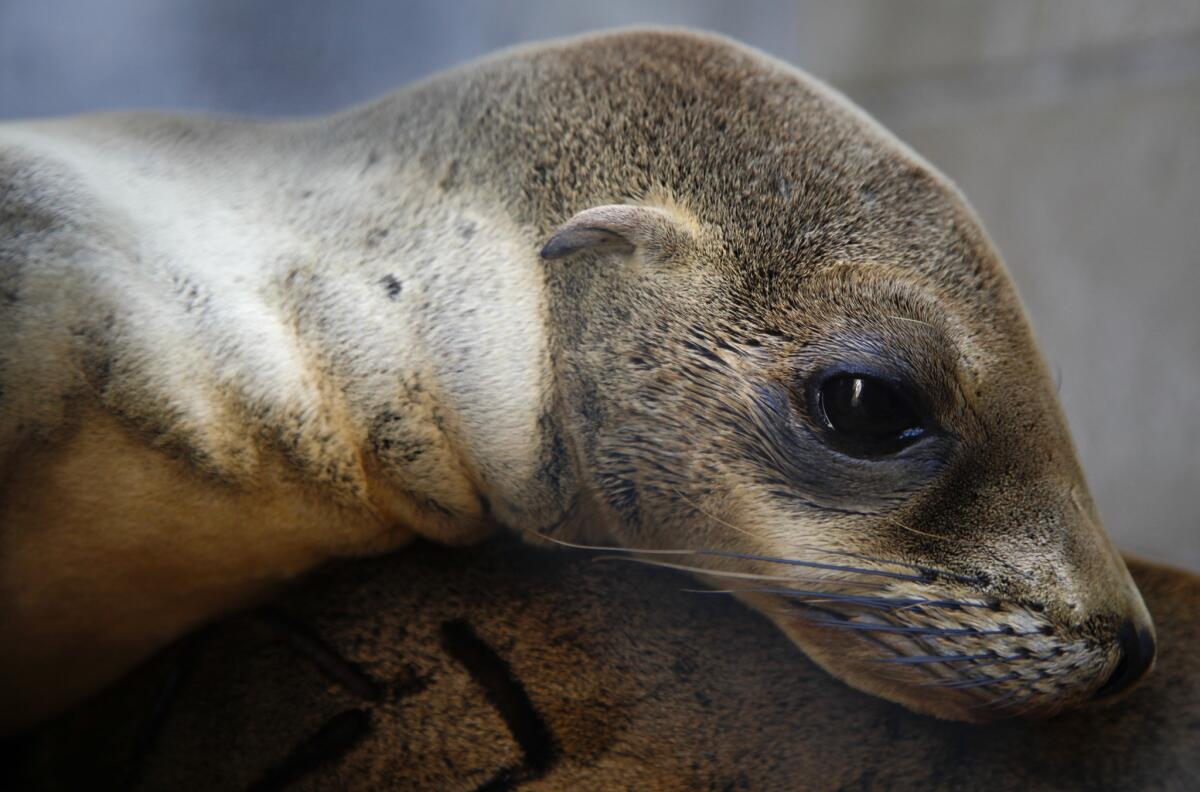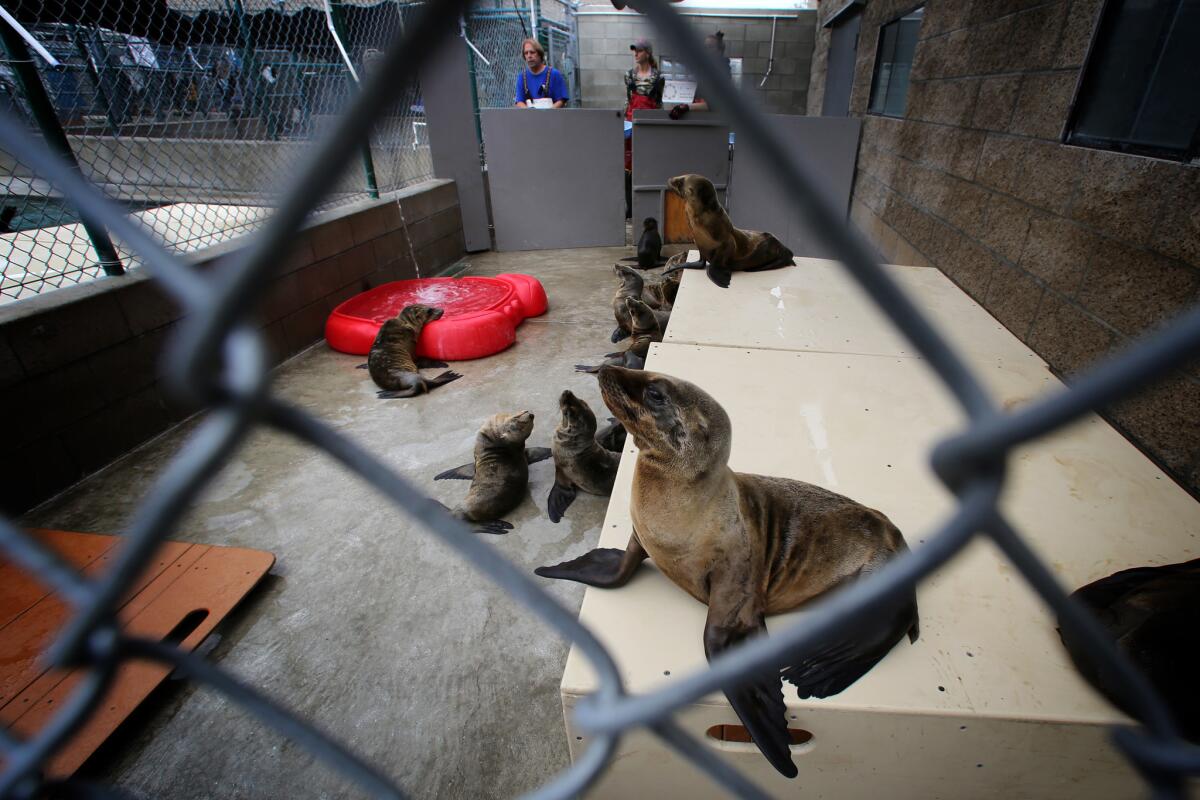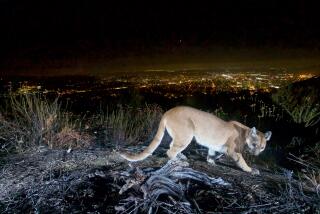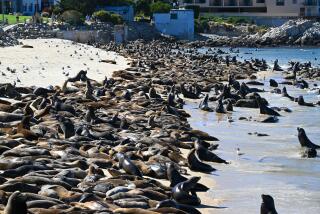Why are so many sea lion pups starving? Scientists find the answer off the Central California coast

An emaciated and sick sea lion pup at the Marine Mammal Care Center in San Pedro in 2013. New research blames a lack of nutritious fish off California’s central coast for the rise in starving pups in Southern California.
Government scientists say there’s a simple explanation for the surge in starving sea lion pups along the Southern California coast: Their mothers can’t find enough nutritious food.
The high-fat, high-calorie fish species that female sea lions prefer to eat have been harder to come by in their usual hunting waters around the Channel Islands breeding colonies, according to researchers from the National Oceanic and Atmospheric Administration. As their preferred sardines and anchovies became less plentiful, they’ve had to settle for rockfish and market squid instead.
The decline in sardines and anchovies and corresponding increase in less nourishing fish explains 81% of the change in sea lion pup weights between 2004 and 2013, the NOAA scientists reported Tuesday in the journal Royal Society Open Science.
See the most-read stories in Science this hour >>
California sea lions have had a precarious existence since the late 1800s, when humans began hunting them for their fur, meat and oil. Many of them also became casualties of fishing operations. By the 1970s, the number of sea lions had dwindled to around 50,000, experts estimate.
The animals’ fortunes began to change in 1972, when President Richard Nixon signed the Marine Mammal Protection Act. With federal protection, the population of Zalophus californianus grew about 5% per year, reaching 340,000 in 2014.

Hunger drove sea lion pups ashore in Southern California in record numbers in 2013. These rescued pups were cared for by the Marine Mammal Care Center at Fort MacArthur in San Pedro.
That progress hasn’t always been steady. In El Niño years, anchovies and sardines became scarce and sea lions switched to rockfish, squid and hake. Previous studies have found that when sea lion mothers eat more rockfish and squid (as determined by analyzing their scat), the pups they nurse have lower body weights.
A team from NOAA’s Fisheries Service wondered whether the effects were limited to El Niño years.
To find out, they needed to know where pregnant and nursing sea lions liked to hunt. They estimated a likely foraging range based on the movements of six female sea lions from San Miguel Island that were tagged by researchers in the 1990s. The data from those tags showed they liked to hunt off the California coast between Big Sur and Malibu.
Next they had to figure out what kinds of fish were available in those waters. For more than 30 years, researchers from NOAA’s Southwest Fisheries Science Center have been taking a census of young rockfish and other fish species in central California. Data for the area they needed was available from 2004 to 2014.
Finally, they looked up the average weight of 14-week-old sea lion pups from San Miguel Island for each year between 2004 and 2011. During that period, the average weight ranged from 14.8 kilograms to 20.9 kg for female pups and from 17.5 kg to 23.6 kg for male pups.
The pattern they found was clear: When sardines and anchovies were abundant and rockfish and squid were scarce, sea lion pups weighed more. Conversely, when rockfish and squid were plentiful and sardines and anchovies were not, sea lion pups weighed less.
The NOAA scientists weren’t able to study the “composition or quantity” of milk produced by sea lion mothers, so they couldn’t make a direct link between the types of fish in the sea and the nutritional value of their milk. Still, the results amount to “compelling evidence” that the pups are starving because their moms can’t produce enough milk for them, the scientists wrote.
At least 375 sea lions have stranded themselves on Southern California beaches so far in 2016, according to NOAA. The study authors said this trend could continue for quite some time.
“We expect repeated years with malnourished and starving sea lion pups,” they wrote.
Follow me on Twitter @LATkarenkaplan and “like” Los Angeles Times Science & Health on Facebook.
MORE IN SCIENCE:
Five ways scientists are going after the Zika virus
Astronaut Scott Kelly spent a year in space. Here are his photos
Are climate-change adaptations tied to protecting property or people? Study follows the money







